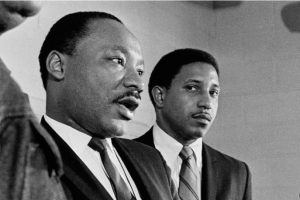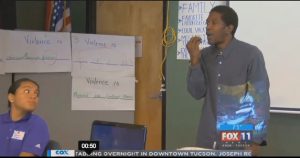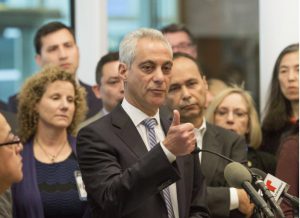. . WOMEN’S EQUALITY . .
An article from Common Dreams (reprinted according to the Creative Commons Attribution-Share Alike 3.0 License)
In response to the imminent Donald Trump presidency, women’s rights advocates nationwide are mobilizing. Men and women from around the country will descend on Washington, D.C., on January 21, 2017 for a “Women’s March on Washington” that organizers hope will see millions in the street, a day after President-elect Trump’s inauguration.

(Photo: Women’s March on Washington/Facebook)
(Click on photo to enlarge)
The demonstrators repudiate the sexist, racist, and Islamophobic remarks that were a touchstone of Trump’s presidential campaign.
Various Facebook pages about the march—organizers in each state are creating their own delegation—have all gone viral, a testament to the powerful opposition to a Trump presidency and what that will mean for women, among other marginalized groups. So far, over 83,000 people have signed up to take part.
“We stand together in solidarity with our partners and children for the protection of our rights, our safety, our health, and our families—recognizing that our vibrant and diverse communities are the strength of our country,” the organizers write.
They continue:
The rhetoric of the past election cycle has insulted, demonized, and threatened many of us—women, immigrants of all statuses, those with diverse religious faiths particularly Muslim, people who identify as LGBTQIA, Native and Indigenous people, Black and Brown people, people with disabilities, the economically impoverished and survivors of sexual assault. We are confronted with the question of how to move forward in the face of national and international concern and fear.
In the spirit of democracy and honoring the champions of human rights, dignity, and justice who have come before us, we join in diversity to show our presence in numbers too great to ignore. The Women’s March on Washington will send a bold message to our new administration on their first day in office, and to the world that women’s rights are human rights. We stand together, recognizing that defending the most marginalized among us is defending all of us.
“The Jan. 21 protest takes its name from the 1963 March on Washington, a historic civil rights rally on the [National] Mall where the Rev. Martin Luther King Jr. delivered his ‘I Have a Dream’ speech,” reports the Washington Post. “The rally will also pay tribute to the 1997 Million Woman March in Philadelphia, in which hundreds of thousands of African American women are reported to have participated.”
Questions for this article
Do women have a special role to play in the peace movement?
The post-election fightback for human rights, is it gathering force in the USA?
[Editor’s note: Here is the official statement from the facebook page of the march:
On January 21, 2017 we will unite in Washington, DC for the Women’s March on Washington. We stand together in solidarity with our partners and children for the protection of our rights, our safety, our health, and our families — recognizing that our vibrant and diverse communities are the strength of our country.
The rhetoric of the past election cycle has insulted, demonized, and threatened many of us–women, immigrants of all statuses, those with diverse religious faiths particularly Muslim, people who identify as LGBTQIA, Native and Indigenous people, Black and Brown people, people with disabilities, the economically impoverished and survivors of sexual assault. We are confronted with the question of how to move forward in the face of national and international concern and fear.
In the spirit of democracy and honoring the champions of human rights, dignity, and justice who have come before us, we join in diversity to show our presence in numbers too great to ignore. The Women’s March on Washington will send a bold message to our new administration on their first day in office, and to the world that women’s rights are human rights. We stand together, recognizing that defending the most marginalized among us is defending all of us.
We support the advocacy and resistance movements that reflect our multiple and intersecting identities. We call on all defenders of human rights to join us. This march is the first step towards unifying our communities, grounded in new relationships, to create change from the grassroots level up. We will not rest until women have parity and equity at all levels of leadership in society. We work peacefully while recognizing there is no true peace without justice and equity for all. HEAR OUR VOICE.
And here are their Guiding Principles:
The Women’s March on Washington is guided by basic principles of human rights with a value on human dignity. We are committed to practicing the following:
➢ Women’s rights are human rights, regardless of a woman’s race, ethnicity, religion, immigration status, sexual identity, gender expression, economic status, age or disability.
➢ We practice empathy with the intent to learn about the intersecting identities of each other. We will suspend our first judgement and do our best to lead without ego.
We follow the principles of Kingian nonviolence, which are defined as follows:
Principle 1:

Nonviolence is a way of life for courageous people. It is a positive force confronting the forces of injustice and utilizes the righteous indignation and spiritual, emotional, and intellectual capabilities of people as the vital force for change and reconciliation.
Principle 2:
The Beloved Community is the framework for the future. The nonviolent concept is an overall effort to achieve a reconciled world by raising the level of relationships among people to a height where justice prevails and persons attain their full human potential.
Principle 3:
Attack forces of evil, not persons doing evil. The nonviolent approach helps one analyze the fundamental conditions, policies and practices of the conflict rather than reacting to one’s opponents or their personalities.
Principle 4:
Accept suffering without retaliation for the sake of the cause to achieve our goal. Self-chosen suffering is redemptive and helps the movement grow in a spiritual as well as a humanitarian dimension. The moral authority of voluntary suffering for a goal communicates the concern to one’s own friends and community as well as to the opponent.
Principle 5:
Avoid internal violence of the spirit as well as external physical violence. The nonviolent attitude permeates all aspects of the campaign. It provides a mirror type reflection of the reality of the condition to one’s opponent and the community at large. Specific activities must be designed to maintain a high level of spirit and morale during a nonviolent campaign.
Principle 6:

The Universe is on the side of justice. Truth is universal and human society and each human being is oriented to the just sense of order of the universe. The fundamental values in all of the world’s great religions include the concept that the moral arc of the universe is long but it bends towards justice. For the nonviolent practitioner, nonviolence introduces a new moral context in which nonviolence is both the means and the ends.









